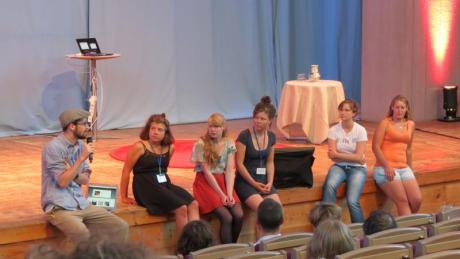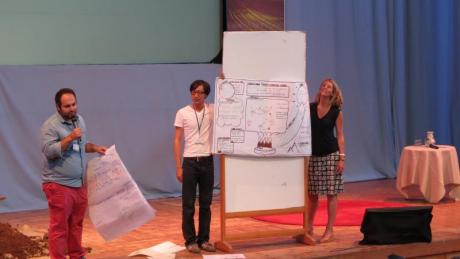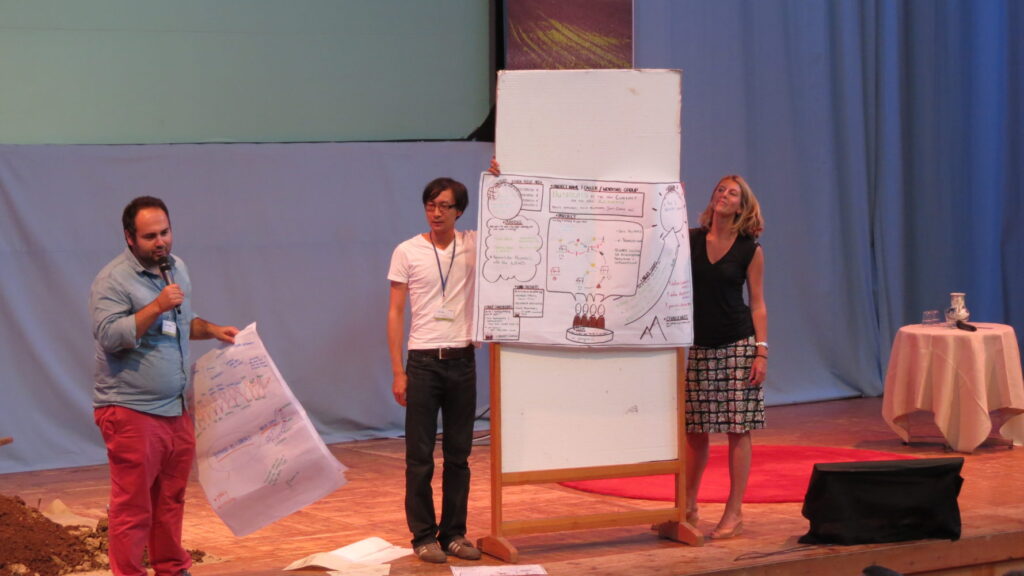We are approaching the end of the Living Soil Forum and so far we have seen many exciting sessions.
The theme of today was to process the fruits of this week’s collaborative developments among the participants. The aim was to tap into the range of knowledge and experiences existing among us and figure out what the next steps would be to make our ideas or projects to come true.
It started with a very encouraging speech by Pavlos Georgiadis from Greece. Pavlos has changed the criteria for how to define success, and by learning permaculture he started to pay attention on how to give life back to soil. He has research experiences around deforestation, soil erosion and floods in Asia and is a trained ethnobiologist. Pavlos has started an olive farm with his family in Greece at the same time as he is co-managing the business start-up We Deliver Taste where the aim is to link consumers with producers. He envisages that, even though socio-economic instability is occurring in Europe and elsewhere, farmers can “farm their way out of crisis”. Through a video blog he is trying to show the challenges with this but also the potential fruits that could be harvested, see it here: https://vimeo.com/foodpolitics
The other two keynote speakers for the day we had the opportunity to interview. Tobias Bandel of the agricultural consultancy company Soil and More gives a background below on how to make a business from teaching organic farming practices in low-income countries. Taking care of all parts of the produced plants through composting is mentioned as an important technique to get long-term value out of everything produced.
Link to SIANI’s interview with Tobias Bandel
In the interview below soil biology professor Håkan Wallander explains to the SIANI team on soil properties associated with organic farming, the role of nutrients, and what practices are important for a long-term sustainable farming.
Link to SIANI’s interview with Håkan Wallander
As mentioned in yesterday’s blog some of the participants presented ideas or newly started projects in which they wished to receive help, input or new collaborative partners. This was a way for us to see beyond the Living Soil Forum and actually create long-lasting impacts leading to a better stewardship of soil. While Petter was occupied with writing our blog I got the chance to engage in one of the projects in organized design labs. First of all I had a difficulty to even choose a project since there were so many relevant projects which sounded fun to participate in. At last I decided to join where I believed I could be the most resourceful. The project was called Soilidarity and was basically only an idea generated a few days ago by a small group of young people who wished to create a non-profit organisation.
The organisation would provide a new type of volunteer service sending volunteers prepared to work hard for poor farmers to restore soils. The group had been inspired by the film “The man who stopped the desert” about the old innovative farmer Yacouba Sawadogo in Burkina Faso. He has regenerated the soil on his farmlands through improved traditional farming techniques. Since my M.Sc. thesis is completely linked to these techniques in this part of the Sahel I could contribute with both knowledge and potential valuable contacts on spot.
Yesterday we did the first brainstorming and wrote essential things to consider with a project; purpose, context, stakeholders, project description, challenges, vision and next steps of the process. Today we got the chance to get input from the other participants during a pro-action café session. It was fascinating to follow the development of this project. It was clear from the onset that the team members were very passionate to move the project from inception to implementation. To paraphrase co-organiser Pieter Ploeg, many of these projects went into a ‘vortex of acceleration; the right people and the right ideas have made the process flowing rapidly’.
After receiving feedback from other participants next step was to make a presentation which we delivered later in the afternoon. Here we got another chance to be very creative and do practically whatever we wanted on stage. One project group invited everyone on stage to sing, another one read out a poem, others went into the role of a farmer and we invited volunteers on stage to come up and dig in dirt. Awards were to be given the next day to projects that stood out in their design or idea.


The day ended by a beautiful dinner and celebration in the lovely summer evening.
Anneli Sundin
SIANI
